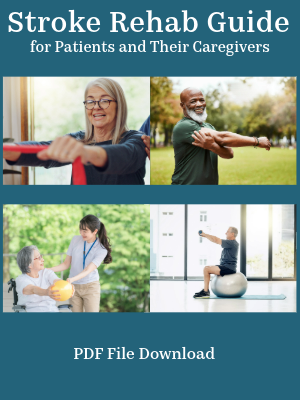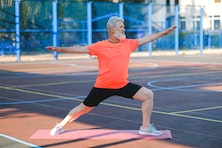Submissions from Readers
Foot and Ankle Swelling
by Joanne
(Wanaque, NJ 07465)
Question: My husband had a hemorrhagic left brain stroke nine years ago. He is in good physical health otherwise and gets around using his cane. His right side was affected and has no use of his right arm. His right foot has always been a bit swollen, usually getting worse as the day wears on.
However, for the past month the top of his right foot, his toes and his ankle have been swollen making it difficult for him to raise his foot properly to walk without tripping, especially without his shoes on. I have him keep it elevated and ice it at the end of the day, and I have also tried a compression stocking.
Can anyone explain why this might be happening now, and is there some other medical condition that might explain it? His diet is excellent and his blood pressure seems to be good. He is not overweight. I have suggested a medical checkup, but it falls on deaf ears.
Thanks for any insight into this.
Answer: Foot swelling after a stroke, can be caused by several factors. If the swelling is only on the affected side, it may be due to reduced mobility, reduced muscle activity, or impaired lymphatic drainage. This can occur because the weakened muscles aren't pumping fluid back to the heart as effectively as before or the lymphatic system, responsible for fluid removal, is less efficient in the affected limb. Another cause of swelling is blood clots. If both feet are swollen, it could be due to underlying circulatory issues, heart problems such as CHF, kidney issues, or medication side effects. Your husband should consult with his physician to rule out a blood clot and find out what is wrong before it causes him to have a fall.
Treatment will depend on the cause of the foot swelling. Some common treatments that are used include:
Medical Interventions
Diuretics: These medications help reduce fluid retention by increasing urine production.Blood Thinners: To prevent blood clots, which can contribute to swelling.
Compression Stockings:These can help improve circulation and reduce swelling. Compression levels are measured in millimeters of mercury (mmHg). The higher the mmHg, the tighter the compression:
As an Amazon Associate I earn from qualifying purchases.
15-20 mmHg: Light compression, often used for everyday wear, travel, and mild swelling.
20-30 mmHg: Moderate compression, often used for varicose veins, mild edema, and post-surgery recovery.
30-40 mmHg: Firm compression, often prescribed for moderate to severe edema, deep vein thrombosis (DVT) prevention, and lymphedema.
40-50 mmHg: Extra-firm compression, typically used for severe medical conditions.
Consult with your healthcare provider to assess and recommend the appropriate level of compression.
Intermittent Pneumatic Compression Devices: Sleeves or cuffs placed around the legs and filled with air in a controlled manner. A physician will determine if an IPC device is appropriate and will provide instructions regarding the duration, frequency, and proper fitting of IPC devices.
Physical Therapy: To strengthen muscles, improve mobility, and reduce swelling.
Lifestyle Modifications
Elevation: Raising your feet above your heart can help reduce swelling. Be careful with elevating pillows that keep the knee bent for prolonged periods as you do not want to cause joint tightness or contractures at the knee.Exercise: Regular physical activity, as recommended by your doctor, can improve circulation.
Weight Management: If overweight, losing weight can reduce pressure on your feet and ankles.
Dietary Changes: Reducing sodium intake can help manage fluid retention.
Specialized Treatments
Lymphatic Drainage Massage: This gentle massage technique can help reduce swelling.Complete Decongestive Therapy (CDT): A comprehensive treatment that includes skin care, compression therapy, exercise, and manual lymphatic drainage.
Each individual's situation is unique, and a healthcare professional can provide the appropriate treatment plan. It's essential to communicate with his doctor to treat and monitor the condition.
Dropfoot
by Ledi
(Philippines)
Question: What do I with drop foot? I' m not comfortable wearing an AFO, Walkaid is expensive.
Answer: There are various braces and straps that can help with drop foot that are not the hard AFOs but rather soft products. You can search AIDER Ankle foot brace for drop foot or Ossur Foot-up. You can also use an ace bandage such as shown in this video: https://www.youtube.com/watch?v=JKaSA_heIdI. You just have to make sure there is enough support to keep your foot from dropping. Some of the soft products may not offer enough support. I would talk to your physical therapist or an orthotist to see if any of these options would be appropriate for you.
Hardened Knees
by Katie
Question: My mom had stroke for almost 2 years now but few months ago she suffered from sepsis.She hasn't been on a therapy for a year now. I think that's the reason why her right knee hardened, leaving it always on a 90-degree angle. She's always on bed nowadays and requires assistance in everything from bathing, eating and drinking etc.She can't sit on her own too. My question is, Is it still possible for her to be able to walk again and live normally?
Answer: If she has spent a lot of time in bed with her knee bent, she probably has developed a knee contracture. I would see an MD who may recommend serial casting or a knee contracture brace which will stretch it out over time. If it is really severe, they may even suggest surgery. The problem with some of the braces and casting is pressure spots so the skin has to be watched closely. Make sure she sees someone who is experienced in working with contractures like these.
Click here to read or post comments
How to Swim with a Weak Right Leg as a Result of a Stroke
by John Ryan
(Spokane, WA)
Question: How can I swim laps with a weak right leg as a result of stroke? I'm thinking about using right leg floaty to reduce the drag from that leg?
Answer: I looked online to see if others had a solution to this problem. Some suggestions were a leg buoy at mid thigh level and buoyancy shorts. It was also mentioned if you use a leg buoy (or pool buoy) that you may need something to tie or secure the legs together as the weak leg will float out to the side. I have not seen or had someone try this so I cannot vouch to the effectiveness of it. Maybe some other stroke patients who are swimmers can chime in and give some suggestions.
Rehab from Hip Surgery on Stroke Side
Question: I had a hemorrhagic stroke Oct 2015 and had labral hip surgery on my stroke side April 2016. The surgeon says the surgery was successful on the particular area, but my hip is not healing. I have pain sitting, standing, moving at a constant 3-4; I still walk, stationery bike and do my exercises, but with pain; daily pain is wearing me down. Do people with a post-stroke surgery not heal properly?
Answer: You mention that your hip is not healing. Has the surgeon indicated to you that the bone is not healing or are you thinking that the hip is not healing because you have pain? Bones can become weaker on the side affected by stroke due to disuse and muscle atrophy, but the bone should still heal. On the other hand, pain after stroke is not uncommon, and some people have a hard time controlling this pain. I would first talk to your surgeon about healing. If healing is not an issue, but pain is the problem then I encourage you to see a pain specialist that deals with post-stroke pain.
Crippled toes
by Mary
(Shell Knob)
Question: I had a stroke three years ago, complete use of my arm and hand but my foot has become very crippled with twisted toes and foot pain on the bottom of my toes. Was fitted for a brace and am wearing but the pain on the bottom of my foot is so bad that it affects my walking ability. Any suggestion as what to do?
Answer: Sometimes patients are fitted with a brace for the foot and ankle but actually may need something specifically geared toward the toes or bottom of the foot such as a toe crest or metatarsal pad. You can learn more at this link:
https://www.stroke-rehab.com/support-files/strokerecoverytipsaugust2013.pdf.
How to Rehab Right Leg and Foot to Drive Again
Question: I recently suffered a stroke on left side of brain, so it has effected my right leg. I have numbness in my right leg and foot. I had a car accident before I knew I was having a stroke, so am afraid to start driving again for fear of "Going Numb" again while driving. Although it has improved a bit since the stroke which was 2 months ago, I still lack feeling in my right leg and foot. I'm doing the leg exercises suggested in your therapy guide, but am wondering what specifically might be good for getting back to driving. Thank you.
Answer: I highly recommend that you look to see if there is driving rehab near you. There are many factors involved in driving that should be assessed such as your reaction time, your ability to manipulate the pedals, the ability to feel the pedals, your peripheral vision as well as other vision tests as sometimes these can be present after stroke without the patient even realizing it. Also, if adaptations need to be made, they can make recommendations for you. Here is a page where you can enter the country and state where you live to see what might be available near you (just leave the name field blank). www.aded.net/search/custom.asp?id=2046
If for some reason you do not have insurance or the financial means to cover such services, I would check with government resources. In the U.S., this would be state resources (it's usually under work vocational rehabilitation or something similar).
Also, it's important to know the laws in your state about returning to driving after injury/stroke as there are laws/guidelines in place to address these situations, and you do not want to put yourself at unnecessary risk.
Muscle Weakness in Ankle
by Ledi Jariol
(Davao City, Philippines)
Question What shall I do with my weak ankle evertors? I'm having trouble when walking.
Answer: Ankle issues are not uncommon after stroke. If you have spasticity in your inverters, this would need to be addressed first. If your evertors do have some movement but are just weak, then you would need to do strengthening or ask your MD or physical therapist (PT) if electrical stimulation might be an option. Check with your PT for strengthening exercises. Ideas for ankle eversion exercises can be found online, but it's always best to consult with your PT for proper technique and to make sure you are doing the exercises that are best for you to improve gait. If there is no muscle contraction in the evertors or they are too weak, you may need to look into an ankle foot orthoses (brace) to help improve gait. Talk to your PT to see what options are appropriate for you.
Leg Problem
by Himanshu Rawat
(Dehradun , India)
Question My father had a stroke 5 years back, and his left side was affected. After medical treatment and physiotherapy, his left hand became almost ok. However, he is not able to bend his left foot from the toe or knee. So it's difficult for him to walk. Is there a particular exercise that could help?
Answer: Ask his physiotherapist if an ankle foot orthoses would help with his foot/knee problems to improve his walking. If he has no active movement, he might benefit from an orthoses (a type of brace) to help improve his gait. He might benefit from a Lema strap or for a cheaper alternative, a theraband can be used for the same effect, but both of these techniques should be taught by a professional and evaluated by a physiotherapist to see if they would be helpful and safe for your father. Here is an example of how a theraband was used to help stroke patients in a pilot study: https://www.semanticscholar.org/paper/Effects-of-Thera-Band%C2%AE-elastic-resistance-assisted-Patil-Rao/6c52bd703eb07a098e25dfd2f19df7571030cafb/figure/0
Toes Curl
Question: Is there a "best" exercise for toes that want to curl when walking Thank you for your input.
Answer: This toes curling is most likely due to tone, and there is no exercise that will necessarily maintain reduced tone. However, you can try exercises to strengthen and stretch your toes like these at https://www.saebo.com/blog/exercises-help-fix-curled-toes-stroke/. You might also consider a foot orthotic. You can consult with an orthotist, foot doctor, or physical therapist who is experienced in fitting/finding the right orthotic for your foot to make sure it is helping extend the toes and not contributing to them curling. You can view various types of foot orthotics in this past issue of Stroke Recovery Tips at https://www.stroke-rehab.com/support-files/strokerecoverytipsaugust2013.pdf.
Treatment Tips from Others
To see tips from other survivors and caregivers about their treatment recommendations, click here.
Get Our Stroke Rehab Guide

Our stroke rehab guide is designed specifically for patients and caregivers. It's in pdf format and can be immediately downloaded. It includes about
- Stroke Definition & Causes
- Stroke Treatment
- Rehabilitation Information for Physical, Occupational and Speech Therapy
- Exercise pictures
- Q&A from patients and caregivers
- Adaptive Equipment & Techniques
- How to Prevent Another Stroke & More!
Medical Disclaimer: All information on this website is for informational purposes only. This website does not provide medical advice or treatment. Always seek the advice of your physician or other healthcare provider before undertaking a new healthcare or exercise regimen. Never disregard professional medical advice or delay seeking medical treatment because of something you have read on this website. See the disclaimer page for full information.
- Home
- Stroke Questions
- Toes Curl























